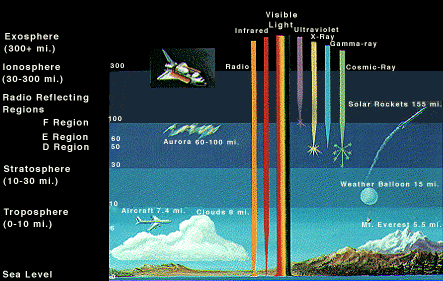
|
|

Conventional
Balloon Flights:
Conventional flights last anywhere from 6 to 40 hours. The balloons fly
as high as 140,000 feet. The balloons are tracked from
an antenna located on the ground near the launch site. Because the antenna requires
a direct line of sight to the balloon, the flights can only be tracked within
a 350 mile radius of the launch site. Outside this radius, all contact would
be lost.
|
|
|
|
Figure 1. The antennas, used to track the balloon flights, are placed on top of the High Bay building, the tallest building on the base. As a result it has the longest line of site on the base. |
Figure 2. On the left you can see the old
navigational charts, used for decades to monitor the trajectory of the
balloon flights. On the right is the current computer upgrade.
|
Long
Duration Balloon Flights:
LDB balloon flights last up to 3 weeks. They are flown out of locations
in Fairbanks, Alaska and Antarctica. The data sent back from these flights are
relayed to the ground by using over-the-horizon satellites such as TDRSS
.
|
Figure 3. This Figure shows the combined trajectories of all the long duration balloon flights made from the balloon base in McMurdo Station, Antarctica from 1991-1996. |
When a balloon launched from Alaska reaches the stratosphere, the winds take
the balloon from East to West. The balloon circumnavigates the globe, crossing
Russia, Northern Europe and then Greenland. In Antarctica the balloons are launched
from McMurdo station
and also travel from East to West.
The balloons
are monitored both for telemetry and science
data during the entire flight. The data are typically recorded to tape or disk
on board . When the mission is complete, the payload
is released from the balloon and parachutes to the ground where it can be retrieved.
Balloons that have been in flight for three weeks have been brought down as
close as 17 miles from the launch site. (See Figure 3.)
|
Figure 4. A balloon launch just getting underway in Antarctica. |
Figure 5. This is the TopHat payload being prepared for flight. |
SCIENCE | INSIDE BALLOONS | LAUNCH | GET INVOLVED | TOUR A BALLOON BASE | WHY A BALLOON? | GLOSSARY | GUESTBOOK |